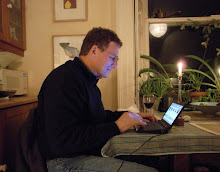 For 33 years, Haddon Sundblom painted advertisements for Coca -Cola that featured Santa Claus. If he didn't create the image of the red-suited, white-bearded, rotund Santa, he certainly fixed it forever in our imaginations.
For 33 years, Haddon Sundblom painted advertisements for Coca -Cola that featured Santa Claus. If he didn't create the image of the red-suited, white-bearded, rotund Santa, he certainly fixed it forever in our imaginations.Sundblom was a highly successful commercial artist and art teacher. In addition to Coke, he drew for Aunt Jemima, Quaker Oats, Cashmere Bouquet, and Playboy, to name a few. He was said to go on two day benders every time he completed a painting, and he was also said to complete them quickly.
Advertising art tends to fade with the snows of yesteryear. But now and then, an image endures, just as certain slogans enter the language and stay. Someone else will have to distinguish fine artists from commercial artists; I can't. Norman Rockwell and N. C. Wyeth were called illustrators in their day, with some condescension. I think we see them as more than that today.
I like Sundblom's Santas, and they're certainly expertly done. So let's add a dram of rum to our Cokes and lift a Christmas bowl to him and to his very fine art.
Coca-Cola Christmas ad from 1951 by Haddon Sundblom (1899-1976). Click on the picture for a closer look.




